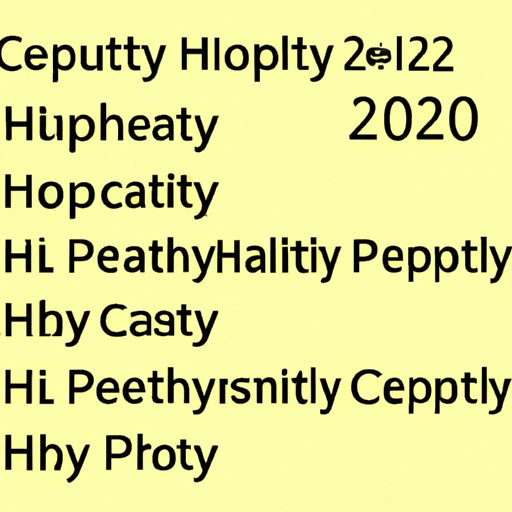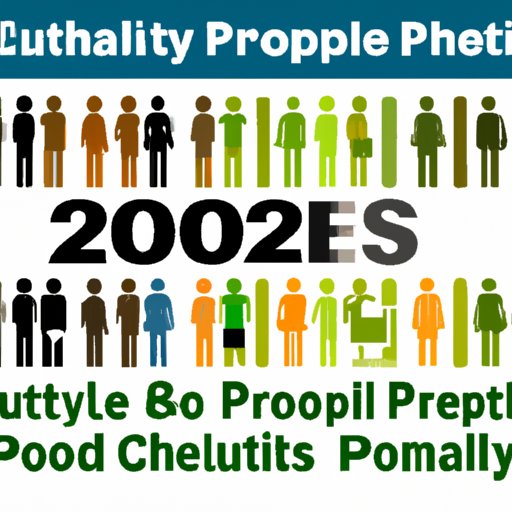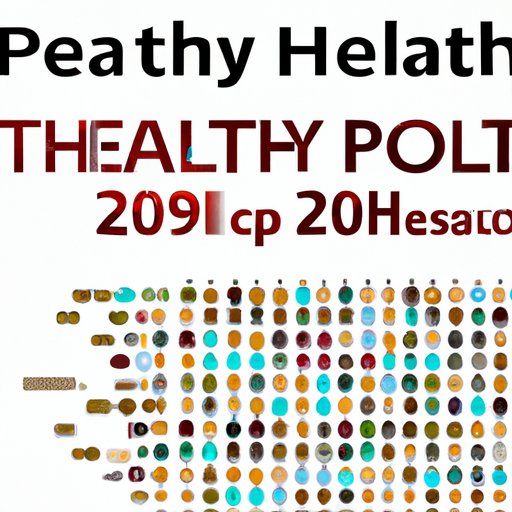Introduction
Healthy People 2030 is an ambitious, 10-year nationwide health initiative created by the U.S. Department of Health and Human Services (HHS). Its aim is to improve the health of all Americans by setting science-based objectives and providing measurable outcomes to track progress. As such, Healthy People 2030 is an invaluable resource for public health professionals, researchers, and students. This article will provide an overview of Healthy People 2030, explain how to cite it in different citation styles, and discuss best practices for using its resources.
Overview of Healthy People 2030
Healthy People 2030 was launched in December 2020 as the fourth iteration of the HHS’s signature public health program. The program seeks to “achieve high-quality, longer lives free of preventable disease, disability, injury, and premature death.” To reach this goal, Healthy People 2030 has identified 41 topic areas, known as “topics,” which are further broken down into more than 1,200 objectives. Each objective has an associated set of data that can be used to measure progress, enabling public health professionals and researchers to track changes in health outcomes over time.
Purpose of the Article
The purpose of this article is to provide a comprehensive guide to citing Healthy People 2030. It will explain the mission, goals, and objectives of Healthy People 2030, outline how to cite it in different citation styles, showcase examples of citations, and discuss best practices for using its resources.

Explain the Goals and Objectives of Healthy People 2030
Mission of Healthy People 2030
The mission of Healthy People 2030 is “to achieve high-quality, longer lives free of preventable disease, disability, injury, and premature death.” To accomplish this mission, the program has identified 41 topics, each addressed through the implementation of measurable objectives. These objectives are meant to “serve as a roadmap for improving the Nation’s health over the next decade.”
Goals and Objectives of Healthy People 2030
The 41 topics outlined by Healthy People 2030 cover a wide range of public health issues, such as mental health, physical activity, and environmental health. Each topic is divided into a series of measurable objectives that are designed to help improve the health of all Americans. For example, under the topic of “Maternal, Infant, and Child Health,” one of the objectives is to “increase the proportion of women who receive early and adequate prenatal care.”

Describe How to Cite Healthy People 2030 in Different Citation Styles
APA Style
When citing Healthy People 2030 in APA style, you should use the following format:
U.S. Department of Health and Human Services. (2020). Healthy people 2030. Retrieved from https://www.healthypeople.gov/
MLA Style
When citing Healthy People 2030 in MLA style, you should use the following format:
U.S. Department of Health and Human Services. “Healthy People 2030.” HealthyPeople.gov, U.S. Department of Health and Human Services, 2020, https://www.healthypeople.gov/.
Chicago Style
When citing Healthy People 2030 in Chicago style, you should use the following format:
U.S. Department of Health and Human Services. “Healthy People 2030.” Accessed October 5, 2020. https://www.healthypeople.gov/.

Outline the Steps to Access the Healthy People 2030 Data
Navigating to the Healthy People 2030 Website
To access the Healthy People 2030 data, the first step is to navigate to the Healthy People 2030 website at https://www.healthypeople.gov/. On the homepage, you can find links to the various topics and objectives outlined by the program.
Finding the Resources You Need
Once you’ve located the specific topic or objective you’re interested in, you can access the associated data by clicking on the “Data & Statistics” link. This will take you to the “Data & Statistics” page, where you can find the relevant data sets, tables, and other resources.

Showcase Examples of Healthy People 2030 Citations
APA
For example, if you were citing the objective “increase the proportion of women who receive early and adequate prenatal care,” your citation in APA style would look like this:
U.S. Department of Health and Human Services. (2020). Healthy people 2030: Maternal, infant, and child health. Retrieved from https://www.healthypeople.gov/node/1069
MLA
Your citation in MLA style would look like this:
U.S. Department of Health and Human Services. “Maternal, Infant, and Child Health.” HealthyPeople.gov, U.S. Department of Health and Human Services, 2020, https://www.healthypeople.gov/node/1069.
Chicago
And your citation in Chicago style would look like this:
U.S. Department of Health and Human Services. “Maternal, Infant, and Child Health.” Accessed October 5, 2020. https://www.healthypeople.gov/node/1069.
Discuss Best Practices for Using Healthy People 2030 Resources
Properly Citing Sources
When using Healthy People 2030 data and resources, it is important to properly cite your sources. This helps ensure that your work is properly attributed, and it also allows other researchers to easily access and verify the data you have used. Therefore, it is essential to follow the appropriate citation guidelines for the style you are using.
Understanding the Limitations of the Data
It is also important to understand the limitations of the data provided by Healthy People 2030. While the data is valuable for tracking changes in health outcomes over time, it is not always complete or reliable. Therefore, it is important to use caution when interpreting the data and to supplement it with other sources whenever possible.
Highlight Benefits of Utilizing Healthy People 2030 Data
Enhancing Public Health Research
Utilizing Healthy People 2030 data can greatly enhance public health research. By tracking changes in health outcomes over time, researchers can gain valuable insights into the effectiveness of public health interventions and policies. In addition, the data can help inform decisions about how to allocate resources and target efforts to improve health outcomes.
Improving Quality of Life
By utilizing Healthy People 2030 data, researchers and public health officials can better understand how to improve the health of all Americans. This, in turn, can lead to improved quality of life, particularly among vulnerable populations. According to a study conducted by the Centers for Disease Control and Prevention (CDC), “the use of Healthy People data and objectives can support evidence-based decision making and help to ensure that all Americans have the opportunity to lead healthy and productive lives.”
Conclusion
Summary
This article provided a comprehensive guide to citing Healthy People 2030. It explained the mission, goals, and objectives of Healthy People 2030, outlined how to cite it in different citation styles, showcased examples of citations, and discussed best practices for using its resources. In addition, it highlighted the benefits of utilizing its data, including enhancing public health research and improving quality of life.
Final Thoughts
As the nation’s premier public health program, Healthy People 2030 offers a wealth of data and resources that can be used to improve the health of all Americans. By understanding how to cite the program correctly and utilizing its data responsibly, researchers and public health officials can make meaningful progress towards achieving the program’s mission.
(Note: Is this article not meeting your expectations? Do you have knowledge or insights to share? Unlock new opportunities and expand your reach by joining our authors team. Click Registration to join us and share your expertise with our readers.)
